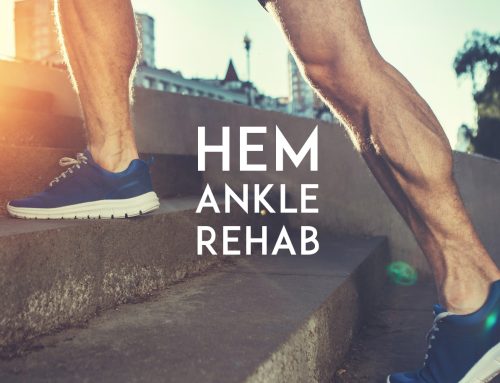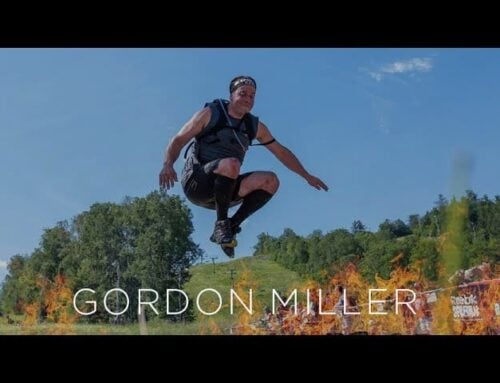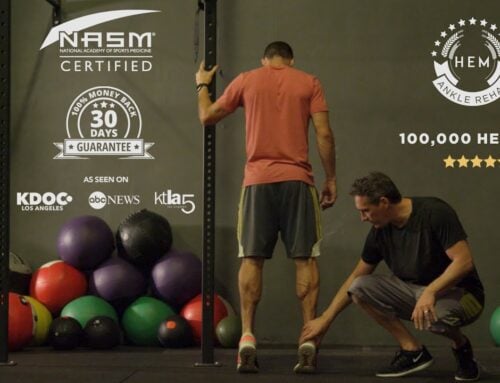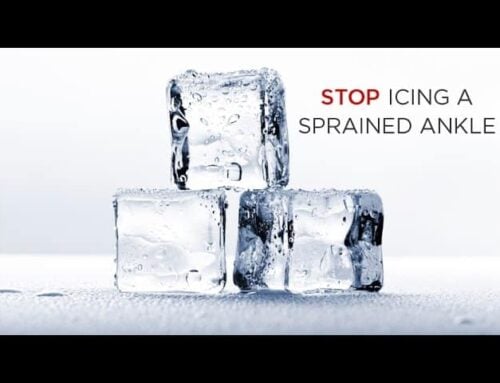
Running faster is a goal that many avid runners and athletes aspire to achieve. Whether you’re a seasoned marathoner or just starting your running journey, increasing your speed can be a rewarding and challenging endeavor. In this comprehensive guide, we’ll explore effective strategies and techniques to help you reach your running speed goals.
#1 Strengthen Your Ankles for Better Performance
In the pursuit of becoming a faster and more efficient runner, the first and most important step is to make sure there is nothing physically hindering your dynamic motion and ability to generate speed and power…
To start, make sure you are not still nursing an old injury that may be slowing you down. If there is, you need to deal with that and make sure you are fully healed.
First and foremost, it’s essential not to overlook the significance of strong and stable ankles, especially since sprained ankles are the #1 most common sports injury. If you have an old ankle sprain that never fully healed, that can slow you down significantly.
Your ankles play a crucial role in maintaining balance, absorbing shock, and providing propulsion during each stride. By strengthening your ankles, you can reduce the risk of injury, improve your running form, and enhance overall performance.
Why Ankle Strength Matters
Before delving into ankle-strengthening exercises, let’s understand why ankle strength is vital for runners:
- Stability: Strong ankles provide stability, reducing the risk of ankle sprains and twists on uneven terrain.
- Balance: Improved ankle strength enhances your ability to balance, which is particularly beneficial when navigating challenging trails or uneven surfaces.
- Shock absorption: Running places significant impact on your lower limbs. Strong ankles help absorb some of this shock, reducing the risk of overuse injuries.
- Efficient propulsion: Ankle strength allows for more efficient push-off during each stride, which can contribute to faster running times.
If you need to heal any kind of old ankle injury or if you just have weak, unstable ankles, check out our at-home program to fully heal your ankle at HEM Ankle Rehab. It was designed to help you significantly strengthen your ankles and reduce the risk of injury. You can unlock 2 powerful videos for instant pain relief right now and it’s FREE >>
Now, let’s cover all the other ways you can learn how to run faster…
How can I increase my running speed?
When it comes to running faster, there are several key factors to consider. Let’s dive into each of these factors and explore how they can contribute to improved speed.
1. Proper Warm-up and Stretching
One of the fundamental aspects of running faster is ensuring your body is adequately prepared for the demands of high-intensity running. Before you hit the track or trail, invest time in a proper warm-up routine. Warming up helps increase blood flow to your muscles, improves flexibility, and prepares your body for more intense physical activity.
Begin with light aerobic exercises like jogging in place or jumping jacks to gradually raise your heart rate. Follow this with dynamic stretching exercises that target major muscle groups. Dynamic stretches, such as leg swings and hip circles, help enhance joint mobility and flexibility.
Static stretching, which involves holding a stretch for an extended period, should be saved for post-run cool-downs. Focusing on dynamic stretching in your warm-up routine will help prevent injury and prepare your muscles for optimal performance.
Remember, a good warm-up should last around 5-10 minutes and should leave you feeling slightly warmer and looser without causing fatigue. This sets the stage for an efficient and safe run.
2. Running Form and Technique
Your running form plays a crucial role in your speed and overall performance. Proper running form not only conserves energy but also maximizes your stride length and efficiency. Here are some tips to improve your running form:
- Maintain an upright posture: Keep your head up, shoulders relaxed, and back straight. Avoid leaning too far forward or backward, as this can lead to wasted energy and decreased speed.
- Land mid-foot: Aim to strike the ground with your foot landing under your hips. Avoid overstriding, as it can lead to braking forces and slower running.
- Use your arms: Swing your arms naturally in coordination with your leg movements. Your arms can provide balance and generate additional power.
- Focus on a smooth stride: Minimize unnecessary vertical movement (bouncing) and excessive side-to-side motion. A smooth, efficient stride is key to faster running.
- Practice cadence: Strive for a higher cadence (steps per minute) as it can help you maintain a faster pace with less effort. A metronome or running app can help you work on this.
3. Interval Training
Interval training is a highly effective method to increase your running speed. It involves alternating between high-intensity sprints and low-intensity recovery periods. This type of training helps improve your cardiovascular fitness and teaches your body to run at faster paces. Here’s how to get started:
- Choose a suitable location: Find a flat, safe, and preferably measured area for your intervals. A track or a flat stretch of road works well.
- Set a goal pace: Determine the pace you want to achieve during your sprint intervals. This pace should be faster than your usual running speed.
- Start with a warm-up: Begin with a 5-10 minute warm-up jog to prepare your muscles.
- Sprint and recover: Run at your goal pace for a specific duration (e.g., 30 seconds), then slow down to a recovery pace (e.g., 2 minutes). Repeat this cycle several times.
- Progress gradually: As you become more comfortable with interval training, increase the duration and intensity of your sprints. This progressive approach will help you build speed over time.
4. Strength Training
Strength training is an often overlooked but critical component of running faster. Building strength in your legs and core can enhance your running efficiency and reduce the risk of injury. Consider incorporating these strength-training exercises into your routine:
- Squats: Squats target your quads, hamstrings, and glutes, which are essential for powerful strides.
- Lunges: Lunges work on your leg muscles and improve stability.
- Planks: Planks strengthen your core, helping you maintain proper posture during runs.
- Calf raises: Strong calves can contribute to better propulsion and faster running.
- Resistance training: Using resistance bands or weights can help you build overall strength.
Integrate strength training into your weekly routine, aiming for at least two to three sessions.
5. Nutrition and Hydration
Proper nutrition and hydration play a significant role in your ability to run faster and recover effectively. Consider the following nutrition tips:
- Pre-run fuel: Consume a balanced meal 1-2 hours before your run, focusing on complex carbohydrates and lean proteins.
- Hydrate adequately: Dehydration can lead to decreased performance. Drink water throughout the day and consider a sports drink during longer runs.
- Recovery nutrition: After your run, replenish your energy stores with a combination of carbohydrates and protein. This aids in muscle repair and glycogen restoration.
- Supplements: Consult with a healthcare professional if you’re considering supplements like creatine or branched-chain amino acids (BCAAs) to support your training.
This wraps up the first section on how to increase your running speed. In the following sections, we’ll explore how to run longer without getting tired and how to improve your mile time. Plus, we’ll discuss the importance of ankle strength and provide you with additional resources to enhance your running journey.
How do I run longer without getting tired?
While increasing your running speed is essential, building endurance is equally vital to achieving your running goals. Running longer distances without feeling fatigued is a hallmark of a well-rounded runner. Here are strategies and tips to help you extend your running endurance:
1. Build Endurance Gradually
One of the most common mistakes new runners make is trying to run long distances right from the start. Instead, aim for gradual progression. Begin by running at a pace and distance that feels comfortable for you. As your body adapts, slowly increase the length of your runs over several weeks.
The “10% Rule” is a valuable guideline to follow. It suggests that you should not increase your weekly mileage or duration by more than 10% to prevent overuse injuries and excessive fatigue. By building your endurance incrementally, you’ll give your body time to adapt and become more resilient.
2. Focus on Breathing
Proper breathing techniques can significantly impact your running endurance. Many runners find it helpful to sync their breathing with their steps. For example, inhale for two steps and exhale for two steps. This rhythmic breathing pattern can help you maintain a steady flow of oxygen to your muscles.
Additionally, practice deep belly breathing to ensure you’re getting sufficient oxygen. Shallow chest breathing can lead to early fatigue. Focus on expanding your diaphragm with each breath, allowing your lungs to fill completely.
3. Mental Strategies
Running longer distances can be mentally challenging, especially when fatigue sets in. Mental toughness is as crucial as physical endurance. Here are some mental strategies to help you push through:
- Set milestones: Break your run into smaller, manageable segments. For example, if you’re aiming for a 10-mile run, focus on reaching the 5-mile mark first. Achieving these milestones can boost your confidence and motivation.
- Positive self-talk: Replace negative thoughts with positive affirmations. Remind yourself of your progress and your ability to overcome challenges.
- Visualization: Before your run, visualize yourself running effortlessly and crossing the finish line. Visualization can help reduce anxiety and boost performance.
- Music and mantras: Create a playlist of energizing songs or repeat motivational mantras to keep your spirits high during long runs.
4. Appropriate Footwear
The right running shoes can make a significant difference in your ability to run longer without discomfort. Visit a specialized running store to get fitted for shoes that suit your foot shape and running style. Wearing the correct footwear can reduce the risk of injuries and enhance your overall comfort during runs.
It’s also essential to replace your running shoes regularly. As a general guideline, consider replacing them every 300-500 miles, depending on factors like your body weight and running surface.
5. Recovery and Rest
Lastly, don’t underestimate the importance of rest and recovery in extending your running endurance. Adequate rest allows your muscles to recover and adapt, which is essential for long-term progress.
- Rest days: Incorporate rest days into your training schedule to give your body time to heal and recharge. Active recovery activities like gentle yoga or swimming can be beneficial on these days.
- Sleep: Ensure you’re getting enough quality sleep. Sleep is when your body repairs and regenerates, helping you perform better on your runs.
- Nutrition: Pay attention to your post-run nutrition. Replenish your body with a combination of carbohydrates and protein to aid in muscle recovery.
By gradually building endurance, focusing on your breathing, adopting mental strategies, wearing appropriate footwear, and prioritizing recovery, you can run longer distances with less fatigue. These techniques will not only improve your overall running performance but also enhance your ability to sustain longer and more enjoyable runs.
How can I improve my mile time?
For many runners, achieving a faster mile time is a significant goal that requires specific training and strategies. Whether you’re looking to set a personal record or simply become a swifter runner, these techniques can help you shave precious seconds off your mile time:
1. Set Specific Goals
The journey to a faster mile time begins with setting clear and attainable goals. Instead of aiming for a generic improvement, specify your desired mile time. A concrete goal, such as “I want to run a 6-minute mile,” gives you a target to work towards and keeps you motivated.
Once you’ve established your goal, break it down into smaller, manageable milestones. For example, if you currently run a mile in 8 minutes, aim for 7:30 first, and gradually progress from there. Tracking your progress and celebrating achievements along the way can be highly motivating.
2. Structured Training Plan
Improving your mile time requires a well-structured training plan that incorporates various workouts to target speed and endurance. Consider these components when designing your training plan:
- Interval Training: Intervals involve short, intense efforts followed by brief recovery periods. For mile improvement, aim for intervals lasting around 400 meters (equivalent to one lap around a standard track). Repeat these intervals with a focus on gradually increasing your pace.
- Tempo Runs: Tempo runs help improve your lactate threshold, allowing you to sustain a faster pace for longer. During a tempo run, aim to run at a pace that feels comfortably hard, but sustainable.
- Hill Training: Incorporate hill repeats to build leg strength and power, which can translate into improved mile times.
- Long Runs: While the mile is a short distance, don’t neglect longer runs. They help enhance overall endurance and contribute to improved mile performance.
- Rest Days: Be sure to include rest days in your plan to prevent overtraining and allow your body to recover.
3. Track Your Progress
To gauge your improvement accurately, track your mile times consistently. Use a GPS watch or a smartphone app to record your times for each mile attempt. Additionally, consider running on the same course or track for consistency in your measurements.
Create a running journal or spreadsheet to log your mile times, training details, and any observations or adjustments you make to your plan. Over time, this data will help you identify trends and assess the effectiveness of your training.
4. Cross-Training
Cross-training can complement your running efforts and contribute to a faster mile time. Activities like cycling, swimming, and strength training can help you build overall fitness, prevent overuse injuries, and improve your cardiovascular capacity.
Incorporate cross-training sessions into your weekly routine. For example, you might dedicate one or two days to activities other than running. This variety not only enhances your physical fitness but also provides a mental break from the rigors of mile-focused training.
5. Consistency is Key
Consistency is perhaps the most critical factor in improving your mile time. Stick to your training plan, even when progress feels slow or challenging. Improvement often comes in small increments, and the dedication to consistent training is what leads to significant breakthroughs.
Remember that running faster requires time and patience. Avoid the temptation to overtrain or push too hard, as this can lead to burnout and injury. Listen to your body, and adjust your training plan as needed to ensure you’re progressing safely and effectively.
Secret of the Pros
Everything You Need To Heal At Home
So, Why Rehab?
Most people think rest and ice will heal their ankle (even a severe sprain), but they end up with chronic ankle instability… 30% still have pain one year later!
And that causes all kinds of muscle imbalances in the body, which can lead more serious injuries, repeated ankle sprains and chronic ankle pain. It’s a terrible domino effect that can last for life.
That’s Where Rehab Comes In.
A great rehab program significantly improves how a sprained ankle heals. It eliminates pain fast and ensures your ankles are strong and stable with healthy range of motion, which helps prevent future sprains.
Rehab Is The Key To
Healing Ankle Injuries Fast
Recent studies have shown that rehab heals ankle ligaments safely and effectively. It’s the difference between the people that don’t heal a sprained ankle and the ones that do!
Injured Ankle
Without Rehab
Injured Ankle
With Rehab
HEM Ankle Rehab “Rehabs” Your Ankle

HEM is a complete ankle rehab and prehab program for the entire ankle, foot and calf complex. This is a very thorough program that contains so much more than anything else you can find online, but it’s still easy to do.
Scott will coach you through every step, as if you are with him, one on one. Just follow along with the videos to rebuild your ankle from the ground up.
You can expect pain free mobility and strong, stable ankles that are protected from an ankle sprain, without ankle braces!
REAL PEOPLE, REAL RESULTS
From Scott Malin, NASM-CPT, CES
Creator, HEM Ankle Rehab
October 25, 2025
Fifteen years ago, I had to give up what I love doing most… playing basketball. I sprained my ankles so many times that I could no longer play. It was devastating.
Like you, I used R.I.C.E. (rest, ice elevation, compression), but my ankles healed so slowly and badly, they eventually got so weak, I would sprain them just walking down the street!
Being a fitness trainer, the only thing I had going for me was a fascination with helping people get out of pain and strengthening their bodies.
So, I decided to research all the cutting edge techniques to heal an ankle sprain much faster and better than R.I.C.E.
After months of research, I discovered that icing an injury can have a negative affect on the body’s healing process. Studies show that ice can actually slow down healing and too much rest left the ankles weak and unstable. This was shocking, but only part of the story…
New research was suggesting a much more proactive approach to healing that involved much better rehab techniques proven to dramatically speed up the speed and quality of the healing process.
Instead of months, healing took only days. And, if you had a chronically weak ankle that was in pain, these techniques would quickly strengthen and stabilize the ankles.
I kept improving on these techniques, drawing from many different disciplines and simplified them.
Eventually, after many more months of trial and error, I created a simple at-home healing system with very reliable results.
Since I was a fitness trainer, I was able to help all my clients (celebrities and athletes) whenever they got injured. I was even on the news a few times.
The response from my clients and friends was so overwhelming that a few of them eventually convinced me to share it with everyone.
Today, I am humbled that over 100,000 people have healed fully and fast with my program.
So, if you have any kind of ankle injury (new or old), just follow along with me in the videos and I’ll show you exactly what to do until you are completely pain free.
My message is simple… you do not have to give up what you love. And you do not have to live with chronic pain from old injuries. Life is too short and there is a better way!
I truly hope you will start using my program so you can get your life back and do what you love, pain free (and yes, I still play basketball every week and LOVE it!)
Thank you!
Scott
Heal Your Ankle FAST ⇣

30 day money back guarantee
15 YEARS. 100K HEALED.

Secret of the Pros
Everything You Need To Heal At Home
REAL PEOPLE,
REAL RESULTS
So, Why Rehab?
Most people think rest and ice will heal their ankle (even a severe sprain), but they end up with chronic ankle instability… 30% still have pain one year later!
And that causes all kinds of muscle imbalances in the body, which can lead more serious injuries, repeated ankle sprains and chronic ankle pain. It’s a terrible domino effect that can last for life.
That’s Where Rehab Comes In.
A great rehab program significantly improves how a sprained ankle heals. It eliminates pain fast and ensures your ankles are strong and stable with healthy range of motion, which helps prevent future sprains.

Rehab Is The Key To
Healing Ankle Injuries Fast
Recent studies have shown that rehab heals ankle ligaments safely and effectively. It’s the difference between the people that don’t heal a sprained ankle and the ones that do!
Injured Ankle
Without Rehab
Injured Ankle
With Rehab
HEM Ankle Rehab
“Rehabs” Your Ankle

HEM is a complete ankle rehab and prehab program for the entire ankle, foot and calf complex. This is a very thorough program that contains so much more than anything else you can find online, but it’s still easy to do.
Scott will coach you through every step, as if you are with him, one on one. Just follow along with the videos to rebuild your ankle from the ground up.
You can expect pain free mobility and strong, stable ankles that are protected from an ankle sprain, without ankle braces!
100,000 PEOPLE HEALED-
-
-
-
-
-
-
-
-
-
-
-
-
-
-
-
-
-
From Scott Malin, NASM-CPT, CES
Creator, HEM Ankle Rehab
October 25, 2025
Fifteen years ago, I had to give up what I love doing most… playing basketball. I sprained my ankles so many times that I could no longer play. It was devastating.
Like you, I used R.I.C.E. (rest, ice elevation, compression), but my ankles healed so slowly and badly, they eventually got so weak, I would sprain them just walking down the street!
Being a fitness trainer, the only thing I had going for me was a fascination with helping people get out of pain and strengthening their bodies.
So, I decided to research all the cutting edge techniques to heal an ankle sprain much faster and better than R.I.C.E.
After months of research, I discovered that icing an injury can have a negative affect on the body’s healing process. Studies show that ice can actually slow down healing and too much rest left the ankles weak and unstable. This was shocking, but only part of the story…
New research was suggesting a much more proactive approach to healing that involved much better rehab techniques proven to dramatically speed up the speed and quality of the healing process.
Instead of months, healing took only days. And, if you had a chronically weak ankle that was in pain, these techniques would quickly strengthen and stabilize the ankles.
I kept improving on these techniques, drawing from many different disciplines and simplified them.
Eventually, after many more months of trial and error, I created a simple at-home healing system with very reliable results.
Since I was a fitness trainer, I was able to help all my clients (celebrities and athletes) whenever they got injured. I was even on the news a few times.
The response from my clients and friends was so overwhelming that a few of them eventually convinced me to share it with everyone.
Today, I am humbled that over 100,000 people have healed fully and fast with my program.
So, if you have any kind of ankle injury (new or old), just follow along with me in the videos and I’ll show you exactly what to do until you are completely pain free.
My message is simple… you do not have to give up what you love. And you do not have to live with chronic pain from old injuries. Life is too short and there is a better way!
I truly hope you will start using my program so you can get your life back and do what you love, pain free (and yes, I still play basketball every week and LOVE it!)
Thank you!
Scott
Hurry, sale ends soon!
30 day money back guarantee



























